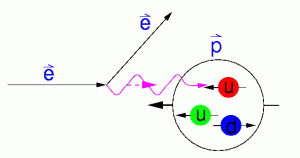Wiki » History » Revision 4
« Previous |
Revision 4/27
(diff)
| Next »
Richard Trotta, 05/20/2024 01:00 PM
- Table of contents
- Research Overview
- Research
Research Overview¶
Professor Zheng’s group conducts research at the Thomas Jefferson National Accelerator Facility (www.jlab.org, or see a short and cool video here). Our research interest includes study of the nucleon structure, with a focus on the spin structure of the nucleon measured using polarized beams and polarized targets. The nucleon structure is determined by how quarks and gluons interact with each other, thus such information could reveal some fundamental properties of the strong interaction and QCD. Experiments that studied this topic include previous 6 GeV A1n and EG4 experiments, the 12 GeV A1n experiment that was completed in year 2020, and the recently completed CLAS12 A1p (RGC) experiment. Another major aspect of our research is testing the Standard Model of Particle Physics by measuring parity violation (PV) in electron deep inelastic scattering (DIS) (see this Nature article on the subject, or for a lighter reading see Dr. Marciano’s Quarks are not ambidextrous). By measuring the PVDIS asymmetry off a hydrogen and a deuterium target, one can access important coupling constants of the Standard Model and study many interesting hadronic effects such as charge symmetry violation and the asymmetry in the sea quark distribution inside the nucleon. Looking forward, future projects that focus on this direction include PVDIS using the upcoming mid-scale equipment project called SoLID and the future electron-ion collider (EIC), The SoLID, if combined with a future positron beam at JLab, also offers the possibility of measuring a new electron-quark effective coupling that was never measured before.
Research¶
About Electron Scattering¶
When we try to study an object, the first thing we do is to observe it under natural light. What happens here is that the light probe (electromagnetic waves in the visible frequency range) scatters off the surface of the object and enters our eye, which is then transmitted to the brain by optical nerves. To study the nucleon is not as simple. The mass of a nucleon (proton or neutron, see figure to the right) is about 1 GeV/c2, or 10-27 kg (or 10-35 of the empire state building). To study such tiny objects, ordinary tools (your naked eye, optical microscope) do not work. What people have been doing is to scatter high-energy beams of electrons or photons (our “probe” for the tiny world) off target made of protons or few-body nuclear systems. The scattered electrons and other particles ejected from the reaction are detected in various detectors (our “sensor”), and the detector signals are transmitted to computers (our “brain”) for further processing. The probabilities for certain scattering process to happen (called “scattering cross sections”) are extracted, and they contains information on the internal structure of the nucleon or nucleus.

Using high energy photon or electron beams to study the nucleon is not only a useful tool, it is also a very “clean” tool: When we use electron beams, what actually happen is that the electrons would exchange a virtual photon with the target (see figure), in other words, the electron interacts with the target through electromagnetic interactions. The electromagnetic interaction is the best understood among all 4 interactions, tested experimentally to 10-9 precision. (Imagine that you have a bank account of $10M and you know where every penny is spent, that is 10-9 precision). Because we know our probe so well, the detected signals would almost unambiguously reflect only the structure of the target.
Updated by Richard Trotta over 1 year ago · 4 revisions